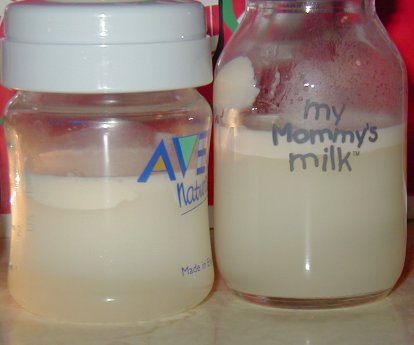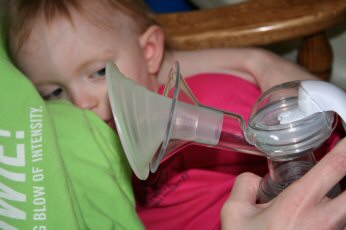The very thought of pumping breastmilk can cause concern for the new mother. Questions like what kind of pump, when, where, and how much to pump are primary concerns, followed by concerns about the milk looking funny, storage issues and how much expressed breastmilk is needed per bottle. The answers to these concerns will vary for both individual mothers and babies depending on their individual needs and circumstances.
The type/brand of pump you choose depends on whether you will be pumping frequently, or only occasionally. It is important to purchase a good quality pump, because poor quality pumps can result in poor performance of pump, and breast soreness. A breast pump is a personal product, and manufacturers do not recommend purchasing a used breast pump. Know the risks involved if you are considering a used pump.
Now infants can get
all their vitamin D
from their mothers’ milk;
no drops needed with
our sponsor's
TheraNatal Lactation Complete
by THERALOGIX. Use PRC code “KELLY” for a special discount!
Check with your doctor and insurance company to see if your pump and other breastfeeding supplies can be covered by your health insurance. Many times with a doctors prescription, insurance companies will pay for a breastpump. This is especially true for mothers of premature or babies that are sick and need special care.
How much you pump depends on individual needs. If you are returning to work your needs for the type/brand of pump and the amount you pump may be very different than if you are pumping occasionally. NOTE: Keep in mind that the average mom who is pumping between breastfeeding sessions can express between ONE and THREE oz per pumping session (not per breast, per session).
Mothers who have spent a lot of time pumping, especially those who have pumped exclusively for long periods, have noted that as you pump, milk will flow and then stop, then flow & stop, then flow & stop, and so on & so on, and it can vary from person to person as to the individual pattern. These mothers recommend if you are trying to increase the amount you can pump, to pump for at least 15 minutes. (you might also continue pumping for 5 minutes after your milk stops flowing).
Most moms need to pump at least 10 minutes, but no more than 20-30 minutes per session.
Be sure that you are comfortable. Some moms use the Pumpin’ Pal breastshield, which inserts into the shield of your regular pump and enables you to lean back while pumping. The idea is to be able to relax a little more.
When you pump can make a difference in the amount you pump. It is quite normal for there to be a lower volume, or amount expressed in the late afternoon and evening hours as opposed to early morning hours. Most experts recommend, especially for the occasional pumper, to express their milk in the early morning hours, about an hour after nursing.
NOTE: It cannot be stressed enough that the amount of milk you able to pump is NOT ever a reliable indicator of how much milk you are producing, nor how much milk baby is taking in. The healthy breastfed baby is usually much more efficient at getting milk from the breast than a pump is.
More here on the amount of expressed milk needed by a baby.
There are many good resources for information on storage and handling of expressed breastmilk. You can freeze your milk for use later, or you can pump and store milk in fridge one day to be used the following day, depending on your individual circumstances.
Milk volume and appearance can and does change throughout the course of the breastfeeding relationship. In the early days after the birth of baby, the body has no idea how much milk to make, so often there is an abundance. After a few weeks, the body regulates and supply adjusts meet the needs of the baby, and the “volume” pumped may be reduced somewhat. Regular pumping will signal the body that there is increased demand, and the supply adjusts to meet these needs. It is normal for there to be a drop in the amount of milk pumped at about 3 months post partum due to a hormonal change. Adjusting pumping and nursing patterns can help compensate for this normal phase of the breastfeeding relationship.
What does breastmilk look like? Breastmilk can be thin and watery looking, and may have a blue or yellow tint to it. It can even take on a hint of green, orange or other color if mother has been eating lots of green foods, or other colored foods, especially those with dye, such as green Gatorade. The color of the milk is usually not anything to be concerned about however it’s always good to check with a breastfeeding professional to be sure.
It does not always look the same because breastmilk changes it’s composition throughout the feedings, as well as throughout the day. As baby grows, breastmilk continues to change to meet the needs for optimal growth, at each stage of baby’s development . This means that mom’s breastmilk at four months is perfectly suited to the needs of her four month old baby, and at six months, perfectly suited for her six month old.
Expressed breastmilk will separate when stored in refrigerator. This can be a real shock to anyone who is not aware that this is normal. Sometimes there is a thick later of “cream” or fat on top, other times a thin layer. Sometimes the milk looks lumpy, or clumpy, and sometimes it can be nearly clear toward the bottom of the bottle. All of the above are completely normal occurrences, and does not mean the milk has spoiled. Spoiled milk has a distinct sour smell. 
The picture here shows an example of what normal breastmilk may look like.
When ready to offer to the baby, one needs only to remove from fridge and gently swirl the milk in a gentle “tornado-like” fashion to remix it. Warm water run over the sides of the bottle will help when the thicker parts stick to the sides of the bottle.
There can be many “ups” and “downs” for the pumping mother, but with patience, and persistence, most obstacles can be overcome. If any difficulties are encountered, it’s always a good idea to contact your local LLL, a board certified lactation consultant, or your local breastfeeding support group for information and/or assistance.

